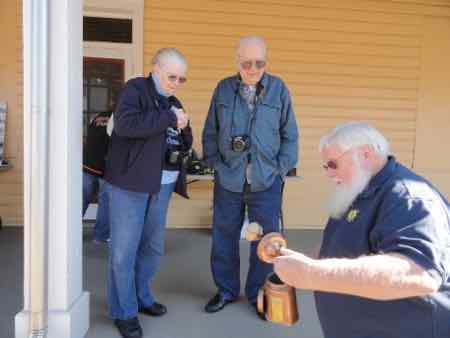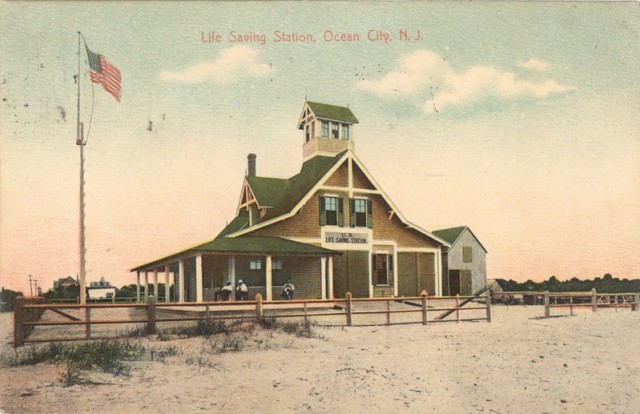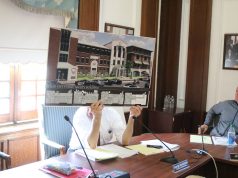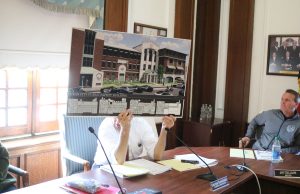Now that Ocean City’s historic Life Saving Station has successfully dodged the wrecking ball and much of its exterior restoration has been completed, the building’s new life as a museum is about to reach its next phase.
U.S. Life Saving Station 30 Chairman John Loeper said interior construction and renovation of the historic building’s interior should begin in June and he hopes it will be completed by January, 2017. The structure, which began operation in 1885, will then be outfitted with period-specific furnishings and many of the artifacts related to building will be placed on display.
“There are not many of these buildings surviving today, and this will be the only one of its type completely restored to a ‘period perfect’ condition,” Loeper said.
Original architectural drawings were found, Loeper said, and an “archeological dig” of the interior revealed the location of the original walls and specific rooms.
“We know where the keeper’s room was, where the kitchen was, the bunk room for the crew and a lot more,” he said. The windows and doors and furnishing will all be restored in a manner faithful to the originals.
Loeper has also documented the names of all 62 men who worked at the station and has located the graves of about half of them. He also recently received a glass negative and photo print of a 1905 keeper and crew. “It is as clear and detailed as a photo from one of today’s digital cameras,” he said.
Visitors won’t feel like they are in a traditional museum. Instead they will get a feel for what the building was like when it operated from 1885 to 1915. The Life Saving Service merged with the Revenue Cutters, a kind of sea-fairing IRS that checked on cargo ships to collect taxes, to form the United States Coast Guard.

“You aren’t going to see a lot of stuff inside of glass cases,” Loeper said. “This is going to be a living history museum. The goal is for it to look like the guys just left to do a rescue.”
Not many people, including Ocean City locals are aware that the building was part of a vast network of similar structures built and operated to aid the numerous shipwrecks of the day. During the period of its operation, most of America’s cargo was hauled by schooners which hugged the coastline, vessels Loeper compared to today’s tractor trailers.
“At that time, more than 150 coastal schooners were sailing past Ocean City every single day. At any given time you could go stand on the beach and see a dozen of them.”
Unfortunately, with that amount of “traffic” shipwrecks were common as well. Each Life Saving station had a Keeper, or boss, Loeper said, and a crew of seven men. The crew members were referred to by number, not name, according to their skill levels. For example, an inexperienced entry level man would be a one and those with top-flight sailing and rescue abilities and experience would be a seven.
“In the heat of a rescue, there was no time to remember or call out a name,” Loeper said. “Also there might be another crew out near the wreck from a neighboring station. Referring to the men by number according to what task needed to be performed could actually save lives.”
The crews would be dispatched and would row out in heavy 26-ft. wooden rowboats to the site of the wreck and attempt to save as many people and as much cargo as possible. Sometimes they would be pressed into duty when cargo (and occasionally bodies) would wash up to shore from the wrecks. The crews attempted to protect the cargo from looters and sometimes would bury the bodies right there on the beach. The victims rarely had ID, Loeper said, and their families would not know where to look for their remains. The victims were simply known to have been lost at sea.
The Life Saving Station also served as temporary shelter for people stuck on the island during a storm. Ocean City was a remote place at that time, and inhabited by very few people.
“If you had come over from Somers Point to fish and the weather turned bad, you could knock on the door and they would put you up until the weather improved,” Loeper said.
Speaking of bad weather, storms around 1905 eroded a large portion of Longport, and that land wound up merging with two islands in the north inlet to form what is now the North end of Ocean City. The island previously ended at North street and the Life Saving Station’s Fourth and Atlantic location was on the beachfront. Although the building has never moved, it currently sits almost a quarter mile from the beach.
Soon it will serve as a reminder of Ocean City’s rich history and the bravery of the Life Saving Station crew members, who themselves were sometimes lost at sea during rescue attempts.
“These guys lead a rough life,” Loeper said. “We need to preserve as much of this history as possible or it will be lost forever.”







